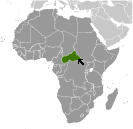World Atlas: Central African Republic. On this page you can see the map, country flag and many detailed information about the people, history and economy of Central African Republic.

Here you can find online selected information about the geography, inhabitants, government, economy and history of Central African Republic. Included are selected statistics, an overview map and the detailed map of Central African Republic. But let's start with the flag of Central African Republic here:
Central African Republic - Overview:
What you should know about Central African Republic? Let's start with this: The former French colony of Ubangi-Shari became the Central African Republic upon independence in 1960. After three tumultuous decades of misrule - mostly by military governments - civilian rule was established in 1993 but lasted only a decade. In March 2003, President Ange-Felix Patasse was deposed in a military coup led by General Francois Bozize, who established a transitional government. Elections held in 2005 affirmed General Bozize as president; he was reelected in 2011 in voting widely viewed as flawed. The government still lacks full control of the countryside, where lawlessness persists. Several rebel groups joined together in early December 2012 to launch a series of attacks that left them in control of numerous towns in the northern and central parts of the country. The rebels - unhappy with Bozize's government - participated in peace talks in early January 2013 which resulted in a coalition government including the rebellion's leadership. In March 2013, the coalition government dissolved, rebels seized the capital, and President Bozize fled the country. Rebel leader Michel Djotodia assumed the presidency and the following month established a National Transitional Council (CNT). In January 2014, the CNT elected Catherine Samba-panza as interim president. Elections completed in March 2016 installed independent candidate Faustin-Archange Touadera as president; he continues to work towards peace between the government and armed groups, and is developing a disarmament, demobilization, reintegration, and repatriation (DDRR) program to reintegrate the armed groups into society.
Geography of Central African Republic
 Where on the globe is Central African Republic? The location of this country is Central Africa, north of Democratic Republic of the Congo. Total area of Central African Republic is 622,984 sq km, of which 622,984 sq km is land. So this is quite a large country. How could we describe the terrain of the country? This way: vast, flat to rolling plateau; scattered hills in northeast and southwest. The lowest point of Central African Republic is Oubangui River 335 m, the highest point Mont Ngaoui 1,410 m. And the climate is tropical; hot, dry winters; mild to hot, wet summers.
Where on the globe is Central African Republic? The location of this country is Central Africa, north of Democratic Republic of the Congo. Total area of Central African Republic is 622,984 sq km, of which 622,984 sq km is land. So this is quite a large country. How could we describe the terrain of the country? This way: vast, flat to rolling plateau; scattered hills in northeast and southwest. The lowest point of Central African Republic is Oubangui River 335 m, the highest point Mont Ngaoui 1,410 m. And the climate is tropical; hot, dry winters; mild to hot, wet summers.
Inhabitants of Central African Republic
Let's take a look how many people live in Central African Republic. The number is: 5,625,118. So this is not very populous country. Who lives here? Baya 33%, Banda 27%, Mandjia 13%, Sara 10%, Mboum 7%, M'Baka 4%, Yakoma 4%, other 2%. What are the languages in Central African Republic? French (official), Sangho (lingua franca and national language), tribal languages. And the religions: indigenous beliefs 35%, Protestant 25%, Roman Catholic 25%, Muslim 15%. How old are the people in average? 19.7 years. We have to add that this number is the median - so one half of the people is older than this, one half is younger. And what is their life expectancy (at birth)? This: 52.8 years. Where the people live in Central African Republic? Here: majority of residents live in the western and central areas of the country, especially in and around the capital of Bangui. The major urban areas of Central African Republic are: Bangui (capital) 794,000 (2015).
Government and Economy of Central African Republic
The capital of Central African Republic is Bangui and the government type presidential republic. Let's take a look at the administrative divisions - 14 prefectures (prefectures, singular - prefecture), 2 economic prefectures (prefectures economiques, singular - prefecture economique), and 1 commune; Bamingui-Bangoran, Bangui, Basse-Kotto, Haute-Kotto, Haut-Mbomou, Kemo, Lobaye, Mambere-Kadei, Mbomou, Nana-Grebizi, Nana-Mambere, Ombella-Mpoko, Ouaka, Ouham, Ouham-Pende, Sangha-Mbaere, Vakaga. Regarding the economy of Central African Republic, important industrial products are gold and diamond mining, logging, brewing, sugar refining. Important agricultural products are cotton, coffee, tobacco, cassava (manioc, tapioca), yams, millet, corn, bananas; timbe. The most important export commodities are diamonds, timber, cotton, coffee and the most important export partners are Belarus 33.5%, Germany 15.3%, France 14.2%, Chad 12.6%, Cameroon 9.7%, China 8.1% (2016). The most important import commodities are food, textiles, petroleum products, machinery, electrical equipment, motor vehicles, chemicals, pharmaceuticals and the most important import partners are Egypt 29.8%, France 18.6%, China 6.8%, Belgium 5.7%, Cameroon 5.4% (2016). How rich is Central African Republic and how rich are people in this country? The most important number here is GDP per capita (PPP): $700 (2017 est.). This is a very low number. Let's add that this means Gross Domestic Product per person, which is recalculated with respect to the relative cost of local goods and services. And one more important number - population below poverty line: NA%.